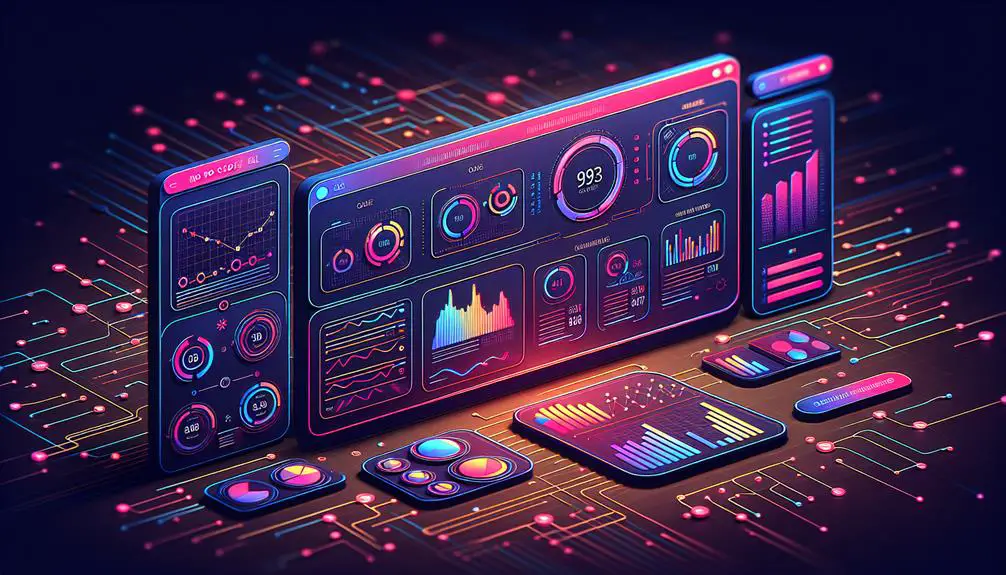No code app builders manage app performance monitoring through integrated analytics tools, real-time monitoring, and third-party integrations. Built-in analytics provide insights into metrics such as app stability and user behavior, helping pinpoint areas for improvement. Real-time monitoring tools offer instant performance metrics and live error detection, ensuring smooth user experiences. Additionally, third-party integrations enhance visibility and provide comprehensive performance management. These platforms also track key performance metrics, resource utilization, and employ optimization strategies to maintain high efficiency and scalability. Learn more to discover how these tools can transform app performance management with minimal effort.
Contents
Key Takeaways
- No code app builders offer built-in analytics tools for monitoring app performance metrics.
- They track user behavior, app stability, and performance bottlenecks for optimization.
- Real-time monitoring tools provide instant performance metrics and live error detection.
- Resource utilization tracking ensures efficient operation and scalability by monitoring CPU, memory, and storage usage.
- Third-party integrations enhance visibility and offer comprehensive performance management insights.
Built-In Analytics Tools
Leveraging built-in analytics tools, no code app builders provide crucial insights into app performance metrics, enabling developers to monitor and optimize their applications effectively. These integrated tools eliminate the need for external solutions, offering developers an efficient means to track various parameters such as user behavior, app stability, and performance bottlenecks.
By closely analyzing these metrics, developers can pinpoint areas that require improvement, ensuring that applications run smoothly.
A critical advantage of built-in analytics tools lies in their ability to track response times and error rates, which are essential for maintaining high app performance. By continually monitoring these metrics, developers can identify and rectify issues before they impact the user experience.
Furthermore, insights into user engagement allow developers to understand how users interact with their applications, providing valuable data that can be used to enhance user experience and optimize app performance.
Key Performance Metrics
Tracking key performance metrics is essential for ensuring the efficiency and reliability of applications built with no code platforms. Metrics such as response time measurement and resource utilization tracking provide crucial insights into app performance, enabling developers to identify and address potential bottlenecks.
These metrics not only help in maintaining optimal user experience but also facilitate proactive issue resolution and scalability.
Response Time Measurement
Response time measurement is a crucial key performance metric that allows no code app builders to assess and enhance app performance. By focusing on response time, builders can ensure smooth user experiences, identifying and mitigating bottlenecks that could impair app functionality. This metric is vital for app performance monitoring, enabling developers to track app performance trends and make necessary adjustments to optimize app performance.
Quick response times are indicative of efficient app performance, providing a seamless user experience, while delays signal underlying issues that must be promptly addressed. Through diligent monitoring of response times, no code app builders can deliver high-performing applications that meet and exceed user expectations.
| Key Aspect | Description |
|---|---|
| Response Time Measurement | Assessing and enhancing app performance |
| App Performance Monitoring | Ensuring smooth user experiences |
| Bottlenecks Identification | Identifying issues that impair app functionality |
| Track App Performance Trends | Monitoring trends and making necessary adjustments |
| Efficient App Performance | Indicating seamless user experiences and addressing delays |
Resource Utilization Tracking
Understanding resource utilization is essential for no code app builders to ensure their applications run efficiently and scale effectively. Resource utilization tracking focuses on monitoring key performance metrics such as CPU, memory, and storage usage. This practice is critical in identifying bottlenecks that may hinder app performance.
By leveraging real-time monitoring, developers gain valuable insights into how resources are being consumed, which is pivotal for maintaining efficient app operation.
Key performance metrics offer a granular view of resource usage, allowing for proactive adjustments to optimize resource allocation. This not only enhances app stability but also ensures that the application can handle increased loads without compromising performance. Scalability, a crucial aspect of modern applications, is significantly bolstered through diligent resource utilization tracking.
The insights gained from monitoring resource usage enable developers to make informed decisions to optimize resource usage. By identifying and addressing inefficiencies promptly, no code app builders can avoid potential pitfalls, ensuring a seamless user experience.
Real-Time Monitoring
Real-time monitoring in no code app builders provides instant performance metrics and live error detection, enabling developers to maintain optimal app functionality.
By continuously tracking response times, error rates, and resource utilization, these tools offer immediate insights into any performance issues.
This real-time feedback allows for swift adjustments, ensuring that apps meet user expectations and perform seamlessly.
Instant Performance Metrics
Instant performance metrics provided by no code app builders empower users to continuously monitor response times, error rates, and resource utilization to ensure optimal app performance. The real-time monitoring tools embedded within these platforms deliver immediate feedback on critical performance metrics. This instant visibility allows users to quickly identify and resolve bottlenecks that could impede app efficiency and degrade the user experience.
By tracking response times, developers can ensure that applications remain responsive under varying loads, thereby maintaining high levels of user satisfaction. Error rates are another crucial metric; real-time monitoring enables swift detection and rectification of issues, minimizing downtime and disruptions. Resource utilization metrics, such as CPU and memory usage, provide insights into how efficiently the app uses system resources. These metrics are vital for optimizing app performance, ensuring that resources are not squandered, thereby enhancing overall app efficiency.
In essence, the real-time monitoring capabilities of no code app builders not only foster a proactive approach to performance management but also significantly enhance the overall user experience. By leveraging these instant performance metrics, users can make informed decisions to continuously optimize their applications for peak performance.
Live Error Detection
Through the integration of live error detection, no code app builders enable immediate identification and resolution of performance issues, thereby ensuring uninterrupted app functionality. Real-time monitoring is a pivotal feature in maintaining optimal app performance and enhancing user experience. This proactive approach allows developers to detect issues as they occur and address them swiftly, preventing minor bugs from escalating into critical errors that could disrupt the user experience.
Key aspects of live error detection in no code app builders include:
- Immediate Detection: Real-time monitoring facilitates the swift identification of performance issues, allowing developers to respond promptly.
- Critical Errors Alerts: App builders provide instant notifications for critical errors, ensuring that developers are aware of and can address these issues before they impact users.
- Enhanced User Experience: By resolving performance issues quickly, developers can maintain optimal app performance, leading to a seamless user experience.
The integration of live error detection equips developers with the tools necessary for continuous app performance monitoring and rapid issue resolution. This not only enhances the reliability of the application but also ensures that the end-users enjoy a smooth and uninterrupted experience, thereby solidifying the app's reputation for quality and dependability.
Bottlenecks and Issues
Identifying and addressing bottlenecks is critical in ensuring the smooth performance and responsiveness of apps built with no code platforms. Performance monitoring is instrumental in this regard, as it helps pinpoint various issues that may affect app speed and reliability. By tracking key metrics such as response times, error rates, and resource utilization, these platforms can identify the exact bottlenecks that need attention.
Real-time monitoring tools enable app builders to detect performance issues as they arise, facilitating immediate interventions that prevent minor problems from escalating into major disruptions. This proactive monitoring approach is essential for maintaining high levels of user satisfaction, as it allows for the resolution of issues before they significantly impact the user experience. Personalized alerts play a crucial role in this process, providing detailed insights and notifications tailored to the specific needs of the app and its users.
Through meticulous performance monitoring and real-time tracking, no code app builders can ensure their applications remain responsive and efficient. By addressing bottlenecks and issues promptly, they can maintain the optimal performance of their apps, thereby safeguarding their reputation and ensuring a seamless experience for their users.
Third-Party Integrations
Integrating third-party monitoring tools such as New Relic, Datadog, or ncScale into no code app builders is an effective strategy for enhancing comprehensive app performance monitoring. These integrations empower users to track critical metrics like response times, error rates, and resource utilization, ensuring optimal app performance. By leveraging third-party integrations, users gain real-time insights into app behavior under various loads, facilitating data-driven decisions to optimize performance.
Third-party monitoring tools offer several key advantages:
- Enhanced Visibility: Integrations with monitoring tools provide a broader view of app performance, allowing for proactive identification and resolution of potential issues before they impact the user experience.
- Real-Time Insights: These tools deliver instantaneous feedback on app performance, enabling swift adjustments and ensuring applications run smoothly under varying conditions.
- Comprehensive Performance Management: Monitoring tools consolidate data from multiple sources, simplifying performance management and providing a holistic understanding of app behavior.
Optimization Capabilities
Optimization capabilities in no-code app builders are crucial for enhancing app performance by systematically addressing bottlenecks and inefficiencies. These platforms are equipped with powerful monitoring tools designed to track critical performance metrics such as response times, throughput, errors, and resource utilization. By identifying bottlenecks early, these tools enable developers to make informed decisions that directly enhance app performance.
One of the standout features of no-code app builders is their use of real-time dashboards. These dashboards provide immediate feedback, allowing for rapid performance adjustments that ensure applications remain responsive and efficient. This real-time monitoring is integral for maintaining high application scalability, ensuring that the app can handle increasing loads without compromising performance.
Moreover, the optimization capabilities embedded within no-code platforms are designed to deliver seamless user experiences. By continuously refining performance parameters through integrated monitoring tools, developers can ensure that their applications operate smoothly even under varying conditions. This not only enhances the overall user experience but also contributes to the long-term viability and success of the application.
Frequently Asked Questions
How Does a No-Code App Builder Work?
No-code app builders operate by offering intuitive drag-and-drop interfaces, enabling users to design and deploy applications without requiring traditional coding skills. These platforms streamline development while incorporating essential features like performance monitoring and analytics.
Does Performance Testing Need Coding?
No, performance testing does not necessitate coding. No code app builders incorporate built-in performance monitoring tools, enabling users to conduct performance testing via intuitive visual interfaces and predefined metrics, simplifying the entire process.
What Four Key Servicenow Platform Capabilities Allow You to Build With No-Code or Pro Code?
The four key ServiceNow platform capabilities enabling no-code or pro-code development are App Engine for rapid application creation, IntegrationHub for seamless integrations, Flow Designer for visual workflow automation, and the comprehensive Now Platform for efficient app development.
How Much Do No-Code Developers Make?
No-code developers earn between $60,000 and $100,000 annually, with junior developers making around $50,000 and senior developers exceeding $120,000. Salaries are influenced by experience, location, company size, and proficiency in platforms like Bubble or Adalo.

